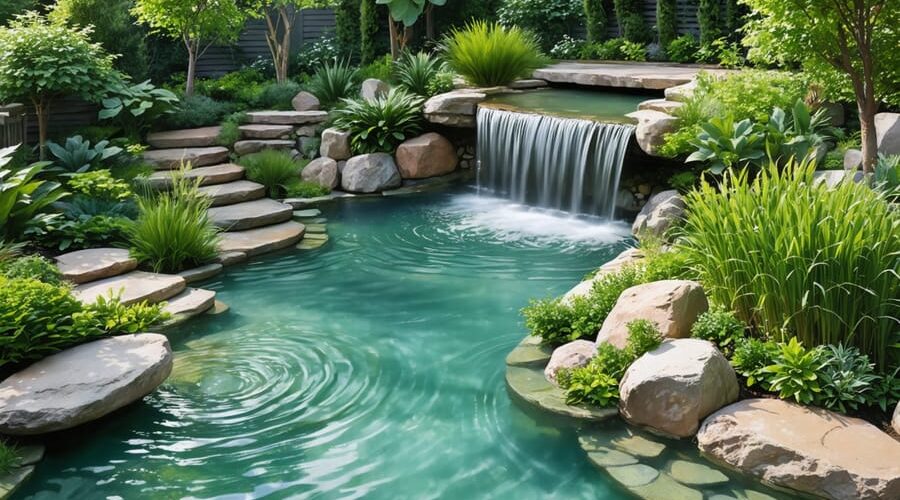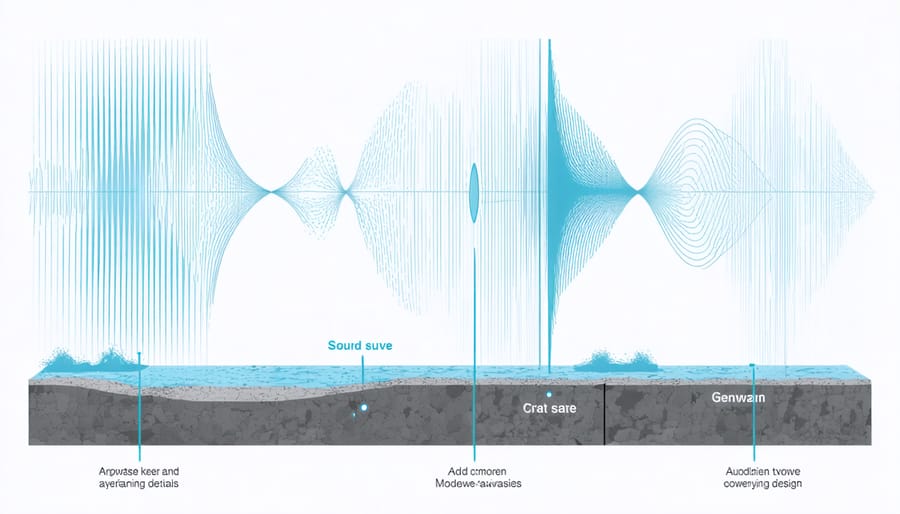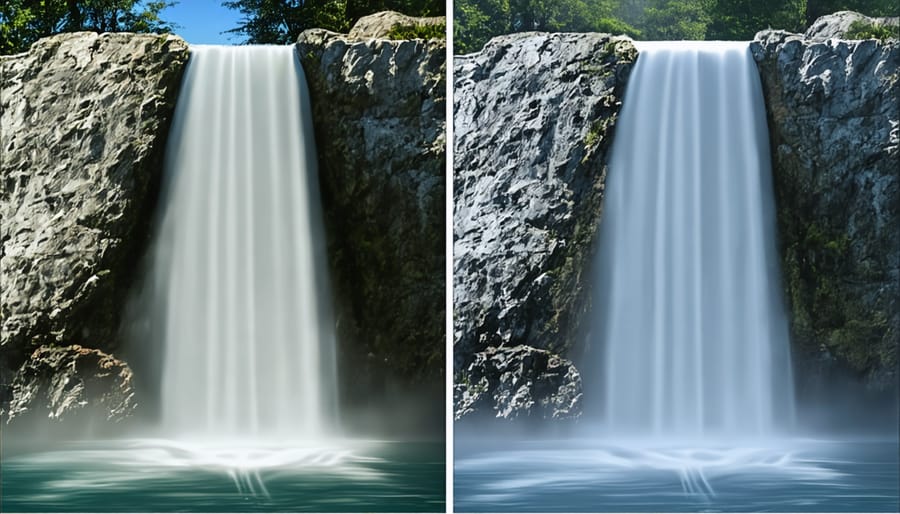
Transform Your Backyard Into a Peaceful Haven: Smart Acoustic Design for Water Features
Transform your backyard into a sensory sanctuary where the gentle splash of water features and rustling leaves create nature’s perfect soundtrack. Outdoor living spaces have evolved beyond mere patios and gardens – they’re now immersive environments where thoughtful acoustic design shapes the entire experience. Whether you’re planning a tranquil meditation corner or a vibrant entertainment area, the way sound moves through your outdoor space profoundly impacts its ambiance and functionality.
Modern outdoor design embraces the art of acoustic landscaping, strategically placing water features, wind chimes, and sound-absorbing plants to craft personalized soundscapes. From the soothing trickle of a tabletop fountain to the dramatic cascade of a multi-tiered waterfall, water elements serve as natural white noise machines, masking unwanted urban sounds while creating a peaceful atmosphere that invites relaxation and conversation.
By understanding how sound travels and interacts with different materials and surfaces, you can design an outdoor living space that not only looks beautiful but sounds beautiful too. Strategic placement of hardscaping, careful selection of materials, and thoughtful arrangement of plants all work together to create an acoustic environment that enhances your outdoor living experience year-round.
The Science of Sound in Outdoor Spaces
Understanding Water Sound Profiles
Water features can transform your outdoor space through their distinctive sound profiles. The gentle trickle of a small fountain creates a soothing backdrop that’s perfect for intimate conversation areas, while a cascading waterfall produces a more dramatic sound that can help mask unwanted noise from nearby streets or neighbors.
For a meditative atmosphere, consider sheet waterfalls that create a consistent, white noise effect. These work wonderfully in zen gardens or reading nooks. Bubbling rocks and small springs offer a subtle, playful sound that won’t overwhelm your space – ideal for compact gardens or patios.
The height of your water feature significantly impacts its sound. Water falling from greater heights produces louder, more energetic sounds, while water moving across flat surfaces creates softer, more peaceful tones. Multiple small drops tend to create a more musical quality compared to a single large stream.
Consider testing different water flow rates before finalizing your design. Lower flow rates produce gentler sounds, while higher flows create more dynamic acoustics. Remember that surrounding surfaces, like rocks or wood, can also influence how water sounds resonate throughout your space.

Natural Sound Barriers and Reflectors
Creating a peaceful outdoor space isn’t just about what you see – it’s also about managing the sounds around you. Plants and landscape features can work wonders in controlling noise levels in your garden. Dense hedges and evergreen shrubs act as natural sound barriers, helping to muffle street noise and create a more tranquil environment.
Tall grasses, like bamboo or miscanthus, not only look beautiful but also produce gentle rustling sounds in the breeze while helping to absorb unwanted noise. Strategic placement of trees can redirect sound waves upward, while solid structures like garden walls or wooden fences can reflect or block sound depending on their position and material.
Water features add another dimension to your garden’s acoustic design. The gentle splash of a fountain can mask unwanted background noise while creating a soothing atmosphere. Consider placing sound-absorbing materials like cork or rubber mulch in key areas to reduce echo and enhance the natural sounds you want to hear.
Remember that sound travels upward, so creating different height levels in your garden with raised beds or terracing can help manage sound distribution more effectively.
Designing Your Water Feature for Optimal Acoustics
Waterfall Height and Flow Rate
Creating the perfect sound ambiance with your waterfall starts with understanding how height and flow rate work together. Like composing music, adjusting these elements helps you achieve the desired acoustic effect in your outdoor sanctuary.
The height of your waterfall directly impacts the sound it produces. A taller fall creates a deeper, more dramatic sound as water hits the surface below, while shorter drops produce gentler, more melodic tones. For a peaceful background melody, consider keeping the fall height between 12-24 inches. If you’re aiming for a more pronounced sound that masks nearby noise, opt for heights of 3-4 feet.
Flow rate is equally important in crafting your waterfall’s voice. A good rule of thumb is to use 1-2 gallons per minute per inch of waterfall width. For example, a 12-inch wide waterfall typically needs 12-24 gallons per minute for optimal sound. Modern pumps make it easy to adjust flow rates, allowing you to fine-tune the sound throughout different times of day.
When planning your water-efficient garden design, consider installing a variable-speed pump. This gives you the flexibility to create different moods – from a gentle trickle during morning coffee to a more robust flow for evening entertainment.
Remember to test different combinations of height and flow rate before finalizing your design. The sound will vary depending on the receiving pool’s depth, the texture of the rocks, and even the surrounding landscape. Don’t be afraid to experiment until you find your perfect water music.

Surface Materials and Textures
The materials you choose for your outdoor living space play a crucial role in creating the perfect acoustic environment. Natural stone, with its varied textures and densities, can help diffuse sound waves and create pleasant echoes around your water feature lighting design. Consider using a mix of smooth and rough-textured stones to achieve the ideal sound balance.
Wooden elements add warmth not just visually but acoustically too. Cedar and redwood are excellent choices for pergolas and decking, as they naturally absorb certain sound frequencies while reflecting others, creating a more balanced outdoor soundscape. For vertical surfaces, try incorporating different materials like bamboo screens or living walls, which help break up sound reflections and reduce echo.
When selecting ground materials, consider how they’ll interact with water sounds. Gravel pathways create their own gentle sound when walked upon, complementing the peaceful atmosphere of your water feature. Meanwhile, softer materials like artificial turf or natural grass help absorb excess noise and prevent unwanted sound reflection.
Don’t forget about fabric elements in your outdoor space. Weather-resistant cushions, curtains, and shade sails not only provide comfort and style but also help absorb sound. Strategic placement of these soft materials can help control sound bounce and create intimate conversation areas.
For areas around water features, textured concrete or natural stone with uneven surfaces helps break up sound waves, preventing harsh echoes. This is particularly important in spaces with multiple hard surfaces, where sound can become overwhelming without proper material selection and placement.
Strategic Plant Placement for Sound Management

Best Plants for Sound Absorption
Creating a peaceful outdoor sanctuary starts with choosing the right plants for sound absorption. Dense, leafy plants are natural sound barriers that can help reduce noise pollution while enhancing your garden’s beauty. When planning wildlife-friendly water gardens, consider these effective sound-absorbing plants.
Bamboo is an excellent choice, with its dense foliage and tall growth pattern creating a natural sound barrier. The rustling of bamboo leaves also adds a pleasant white noise effect to your garden. Holly bushes, with their thick evergreen leaves, provide year-round sound absorption while offering visual privacy.
Ornamental grasses like fountain grass and maiden grass are particularly effective at dampening sound waves. Their numerous blade-like leaves create multiple surfaces that break up and absorb sound energy. Plus, they add beautiful movement and texture to your landscape.
For smaller spaces, try mass plantings of ferns and hostas. Their broad leaves effectively trap and diffuse sound waves at lower garden levels. Evergreen shrubs like boxwood and laurel create dense sound barriers while maintaining their effectiveness throughout all seasons.
Remember to plant in layers, combining tall, medium, and ground-cover plants. This multi-layered approach maximizes sound absorption while creating a lush, natural look. Position your sound-absorbing plants strategically near noise sources or areas where you spend the most time outdoors.
Creating Sound Corridors
Creating sound corridors in your outdoor space is like orchestrating nature’s symphony. By strategically arranging plants and structures, you can direct sound waves to enhance pleasant noises while minimizing unwanted ones. Tall, dense plantings of bamboo or ornamental grasses can act as natural sound barriers, while creating peaceful pathways for desired sounds like water features or wind chimes.
Start by identifying the main sources of sound in your garden – both wanted and unwanted. Place taller plants like cypress or arborvitae along property lines to buffer street noise. Create layers of different plant heights, with medium-sized shrubs and perennials in the middle ground, and lower-growing plants near seating areas.
Consider the texture of your plants too. Plants with large, soft leaves like hostas help absorb sound, while plants with smaller, harder leaves can reflect and scatter sound waves. Mixing these textures creates a more balanced acoustic environment.
Water features can be positioned to maximize their soothing sounds. Place them where sound can bounce off nearby walls or structures, amplifying the peaceful trickling effect. Remember that sound travels upward, so elevated plantings can help direct water sounds toward seating areas.
For maximum effect, incorporate plants that create their own gentle sounds. Quaking aspens and ornamental grasses rustle pleasantly in the breeze, adding another layer to your garden’s acoustic design. This natural white noise can help mask less desirable sounds while creating a more immersive outdoor experience.
Maintenance Tips for Acoustic Performance
Regular Sound Checks and Adjustments
Regular sound checks are essential for maintaining the perfect acoustic ambiance in your outdoor living space. Start by establishing a baseline for your desired sound levels during different times of the day. Morning coffee might call for gentle trickling sounds, while evening entertainment might benefit from more pronounced water features.
Set a weekly schedule to listen to your water features from various points in your garden. Pay attention to how water flow affects sound production – faster flows create more energetic sounds, while slower flows produce calmer, more meditative effects. Make adjustments to pumps and spillways accordingly.
Modern technology has made sound management easier than ever. With smart water feature automation, you can program different flow rates for different times of the day, ensuring your water feature’s sound perfectly matches your lifestyle patterns.
Keep an ear out for any unusual noises that might indicate maintenance issues. Gurgling or sputtering sounds often signal air in the system, while grinding noises might mean pump problems. Quick identification of these issues helps maintain optimal sound quality and prevents equipment damage.
Consider seasonal adjustments too. Wind patterns change throughout the year, affecting how sound travels in your garden. You might need stronger water flow during breezy seasons to maintain the desired sound level, while gentler flows work better during still summer evenings.
Seasonal Acoustic Considerations
The sound of your outdoor space changes dramatically with the seasons, and understanding these shifts helps create a more enjoyable environment year-round. During spring and summer, the natural chorus of birds and insects adds vibrant layers to your garden’s acoustics. Consider enhancing these natural sounds with wind chimes or water features that complement rather than overpower the seasonal symphony.
As autumn approaches, falling leaves can actually dampen sound, creating a more intimate atmosphere. This is the perfect time to adjust water flow rates in fountains or waterfalls, possibly increasing them slightly to maintain your desired sound levels. Consider adding decorative grasses that rustle pleasantly in autumn breezes.
Winter brings its own acoustic challenges and opportunities. Snow acts as a natural sound insulator, creating a peaceful stillness. During this season, you might want to incorporate features like crackling fire pits or adjust existing water features to create deeper, more resonant tones that carry well in the crisp air.
Seasonal changes also affect how sound travels through your space. Humid summer air carries sound differently than dry winter air, and dense foliage affects sound reflection differently than bare branches. Keep these factors in mind when positioning speakers, water features, or conversation areas throughout the year.
Remember to regularly maintain your acoustic features, clearing debris from water features in fall and protecting sensitive equipment during winter months. This ensures consistent sound quality across all seasons.
As we’ve explored throughout this guide, the acoustic elements of your water garden can transform an ordinary outdoor space into a captivating sensory retreat. By thoughtfully implementing the principles we’ve discussed – from selecting the right water feature size to positioning rocks for optimal sound reflection – you can create your own peaceful sanctuary that delights both the eyes and ears.
Remember that successful acoustic design doesn’t require a complete garden overhaul. Start small by experimenting with water flow rates or adding strategically placed stones to your existing features. Listen to how the sounds change throughout the day and during different weather conditions. This mindful approach will help you fine-tune your garden’s acoustic personality.
Don’t be afraid to get creative with your design choices. Mix different water features, play with varying heights, or incorporate multiple sound elements to create a rich, layered soundscape. The key is finding the perfect balance that suits your space and personal preferences.
Most importantly, take time to enjoy the results of your efforts. Create comfortable seating areas where you can immerse yourself in the soothing sounds of your water garden. Whether you’re seeking a peaceful morning meditation spot or a tranquil evening retreat, your acoustically designed water garden will provide the perfect backdrop for relaxation and rejuvenation.
Now it’s your turn to bring these ideas to life in your own outdoor space. Happy gardening!
